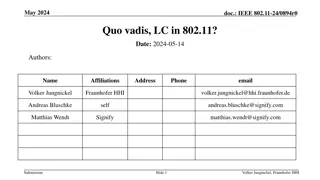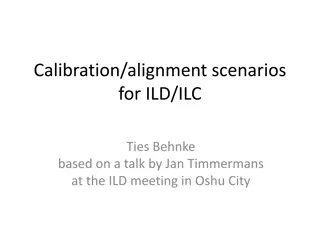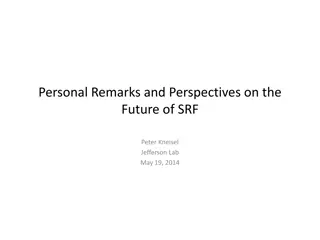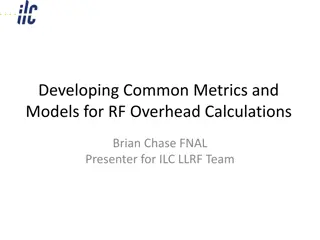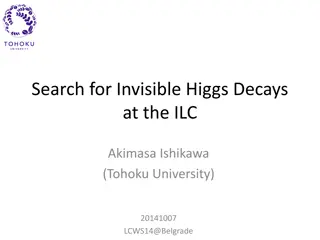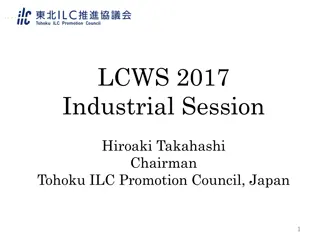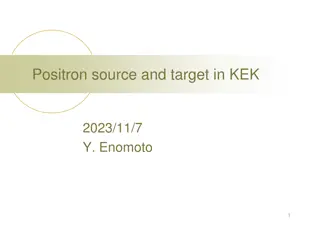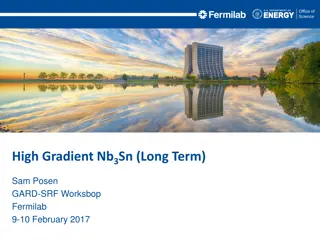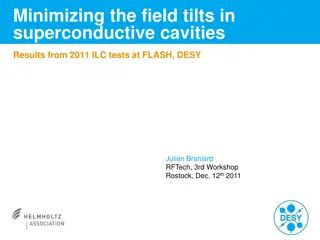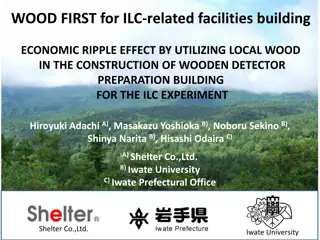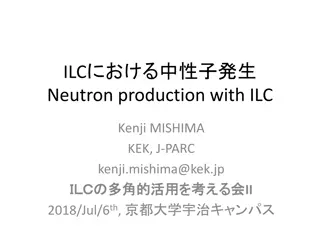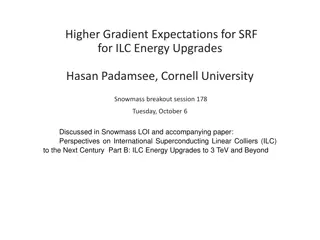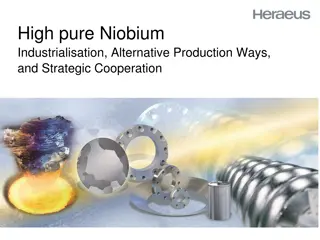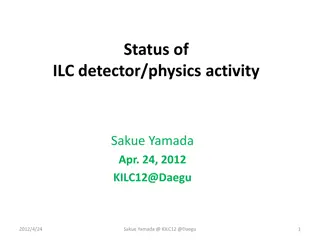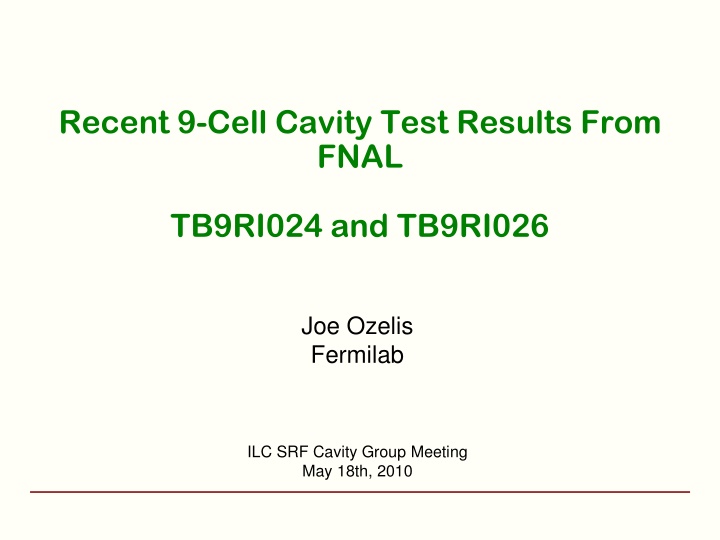
Recent 9-Cell Cavity Test Results and Cavity Performance Overview
This content discusses the recent test results of 9-cell cavities (TB9RI024 and TB9RI026) from Fermilab, including details on fabrication, processing, and performance evaluation. It also covers the history and performance of the TB9RI024 cavity, highlighting its quality factor, radiation levels, and gradients. The analysis includes key observations on cell fields, quench behavior, and signal transmission during testing sessions. Overall, the focus is on assessing the performance and characteristics of these cavities in the context of SRF technology.
Download Presentation

Please find below an Image/Link to download the presentation.
The content on the website is provided AS IS for your information and personal use only. It may not be sold, licensed, or shared on other websites without obtaining consent from the author. If you encounter any issues during the download, it is possible that the publisher has removed the file from their server.
You are allowed to download the files provided on this website for personal or commercial use, subject to the condition that they are used lawfully. All files are the property of their respective owners.
The content on the website is provided AS IS for your information and personal use only. It may not be sold, licensed, or shared on other websites without obtaining consent from the author.
E N D
Presentation Transcript
Recent 9-Cell Cavity Test Results From FNAL TB9RI024 and TB9RI026 Joe Ozelis Fermilab ILC SRF Cavity Group Meeting May 18th, 2010
Recent Cavity Test Subjects Recent Cavity Test Subjects TB9RI024 new cavity fabricated by RI, bulk EP performed at RI, remainder of processing at FNAL/ANL and JLab (800 C H de- gassing). First test w/OST s (second-sound sensors). TB9RI026 new cavity fabricated by RI, all processing at FNAL/ANL (bulk and final EP, HPR, etc.) except 800 C H de-gassing at JLab. Cavity sat in the Dewar at 4.5K for ~2 weeks due to cryoplant compressor failure/replacement. Note: all tests performed at 2K with cavity actively pumped, fixed input coupling (typically between 6x109 to 1x1010). Cooldown is fast - 1 to 2 minutes between 140-100K. Full cable calibrations performed for each test reproducibility of calibration 3-4%. 2 2 May 18, 2010 May 18, 2010 J. Ozelis ILC SRF Cavity Group Meeting J. Ozelis ILC SRF Cavity Group Meeting
Cavity History : TB9RI024 Cavity History : TB9RI024 Fabricated by RI Bulk (130 m) EP at RI Inspections (visual, CMM, RF, optical) H de-gassing (800 C, 2 hours) @ JLab Light EP (70 minutes), HPR, assy 120 C bakeout (63hrs) Vertical test 3 3 May 18, 2010 May 18, 2010 J. Ozelis ILC SRF Cavity Group Meeting J. Ozelis ILC SRF Cavity Group Meeting
Cavity Performance : TB9RI024 Cavity Performance : TB9RI024 ILC- TB9RI024 - Q vs E Tested 4/8/10 - Final EP & HPR @ ANL, then 120 C bake 1.E+11 1.E+04 Low field Q0 = 1.75 x 1010 1.E+03 Radiation (mR/hr) 1.E+10 1.E+02 1.E+01 Q0 Quench 1.E+09 1.E+00 1.E-01 1.E+08 1.E-02 0 5 10 15 20 25 30 35 40 Gradient (MV/m) Quench at 28.8 MV/m, Q0 at quench = 6.5 x 109 FE onset at 23.6 MV/m, radiation levels moderate. Fairly strong Q- slope beginning at ~ 20MV/m, even without presence of FE. 4 4 May 18, 2010 May 18, 2010 J. Ozelis ILC SRF Cavity Group Meeting J. Ozelis ILC SRF Cavity Group Meeting
Cavity Performance : TB9RI024 Cavity Performance : TB9RI024 TB9RI024 - Cell Fields 40 35 30 Field (MV/m) 25 20 15 10 5 0 1 2 3 4 5 6 7 8 9 Cell # Cells 2/8 lowest performing, quench at 24MV/m. Four OSTs (second sound) were mounted on the test stand insert, preliminary data suggest cell #2. 5 5 May 18, 2010 May 18, 2010 J. Ozelis ILC SRF Cavity Group Meeting J. Ozelis ILC SRF Cavity Group Meeting
Cavity Performance : TB9RI024 Cavity Performance : TB9RI024 Signals during a quench in the 8 /9 mode from 4 OST s mounted vertically along cavity cage. Channel 1 is at cell #1, channel 4 is at cell #9, channels 2 & 3 are roughly equidistantly placed between them. Green traces are OST signals, red is the cavity transmitted power. Data is taken at 1.85K, at 25.6kHz. Shortest signal delay is on channel 1, indicating that in the 8 /9 mode, cell #1 (rather than cell #9) is the quench source. (D. Sergatskov) 6 6 May 18, 2010 May 18, 2010 J. Ozelis ILC SRF Cavity Group Meeting J. Ozelis ILC SRF Cavity Group Meeting
Cavity Performance : TB9RI024 Cavity Performance : TB9RI024 ILC-TB9RI024 - Rs vs T Tested 4/8/10 - Final EP & HPR @ ANL, then 120 C bake 20 15 Rs(n ) 10 5 Residual resistance = 6.6 0.5 n 0 0.5 0.55 0.6 0.65 0.7 1/T (1/K) Residual resistance = 6.6 n somewhat on the high side for EP 9- cell cavities, but a generally good value. 7 7 May 18, 2010 May 18, 2010 J. Ozelis ILC SRF Cavity Group Meeting J. Ozelis ILC SRF Cavity Group Meeting
Cavity Performance : TB9RI024 Cavity Performance : TB9RI024 Optical inspection performed after vertical test - no obvious defect observed on cell #2. Overall surface appears etched (somewhat high residual surface resistance?). Next steps : Light EP (~ 20 m) HPR/assy 120 C bake Vertical test Photo courtesy D. Sergatskov 8 8 May 18, 2010 May 18, 2010 J. Ozelis ILC SRF Cavity Group Meeting J. Ozelis ILC SRF Cavity Group Meeting
Cavity History : TB9RI026 Cavity History : TB9RI026 Fabricated by RI Inspections (visual, CMM, RF, optical) Bulk EP (2x, 80 m + 70 m) US cleaning, HPR Optical inspection H de-gassing (800 C/2 hrs) @ JLab Tuning Light EP (26 m), HPR, Assy 120 C bake, 63 hrs Vertical test 9 9 May 18, 2010 May 18, 2010 J. Ozelis ILC SRF Cavity Group Meeting J. Ozelis ILC SRF Cavity Group Meeting
Cavity Performance : TB9RI026 Cavity Performance : TB9RI026 ILC- TB9RI026 - Q vs E Tested 4/26/10 - Bulk & Final EP & HPR @ ANL, then 120 C 1.E+11 1.E+03 Initial low-field Q0 = 1.8 x 1010 Eventual limit Initial run 1.E+02 Radiation (mR/hr) 1.E+10 1.E+01 After 29 MV/m peak 1.E+00 Q0 1.E+09 1.E-01 1.E-02 1.E+08 1.E-03 0 5 10 15 20 25 30 35 40 Gradient (MV/m) Initial FE onset at 25MV/m (after a few bursts at 20MV/m), increased with gradient until cavity reached 29MV/m. Quenched from FE at 29MV/m, then much reduced field (16-17MV/m, then down to 14MV/m) and higher FE. Cavity now limited by FE FE increased sharply while testing. 10 10 May 18, 2010 May 18, 2010 J. Ozelis ILC SRF Cavity Group Meeting J. Ozelis ILC SRF Cavity Group Meeting
Cavity Performance : TB9RI026 Cavity Performance : TB9RI026 TB9RI026 - Cell Fields 40 35 30 Field (MV/m) 25 20 15 10 5 0 1 2 3 4 5 6 7 8 9 Cell # Mode measurements show FE in all modes, least in /9 (cell 5 only), highest in 2 /9 and 3 /9 (cell pairs 3/7 and 2/8). Individual mode gradient limits are due to FE behavior, and not intrinsic (defect) limitations. Some evidence of emitter processing was observed while performing mode measurements so -mode checked again 11 11 May 18, 2010 May 18, 2010 J. Ozelis ILC SRF Cavity Group Meeting J. Ozelis ILC SRF Cavity Group Meeting
Cavity Performance : TB9RI026 Cavity Performance : TB9RI026 ILC- TB9RI026 - Q vs E Tested 4/26/10 - Bulk & Final EP & HPR @ ANL, then 120 C bake 1.E+11 1.E+03 1.E+02 ILC- TB9RI026 - Q vs E Tested 4/26/10 - Bulk & Final EP & HPR @ ANL, then 120 C bake Radiation (mR/hr) 1.E+11 1.E+10 1.E+01 Final Run Initial Run 1.E+00 Q0 1.E+10 1.E+09 1.E-01 1.E-02 Q0 1.E+09 1.E+08 1.E-03 0 5 10 15 20 25 30 35 40 Gradient (MV/m) J. 1.E+08 After mode measurements where FE processing was observed, cavity now reached 19.6MV/m in the -mode (up from 14MV/m, but well below initial run to 29MV/m). 0 5 10 15 20 25 30 35 40 Gradient (MV/m) Comparison of initial (pre strong emitter turn- on) and final (post mode meas.) Q0 vs E curves. Low-field Q0 behavior is unchanged, but Q0 drops sharply at 16MV/m due to strong FE (FE onset 15 MV/m). Limited by strong FE/Q-drop. 12 12 May 18, 2010 May 18, 2010 J. Ozelis ILC SRF Cavity Group Meeting J. Ozelis ILC SRF Cavity Group Meeting
Cavity Performance : TB9RI026 Cavity Performance : TB9RI026 ILC-TB9RI026 - Rs vs T Tested 4/26/10 - Bulk & Final EP & HPR @ ANL, then 120 C bake 25 20 15 Rs(n ) 10 5 Residual resistance = 10.4 0.4 n 0 0.45 0.5 0.55 0.6 0.65 0.7 1/T (1/K) Residual surface resistance = 10.4n a rather high value compared to typical (good) EP d 9-cell cavities (4.5 6.0 n ). Is the degradation due to the activation of a strong emitter, which subsequently globally affects the cavity surface? Q0 vs T measurements are performed at low fields (3-4 MV/m) where FE is not active, so it does not affect the Q0 vs T measurement. 13 13 May 18, 2010 May 18, 2010 J. Ozelis ILC SRF Cavity Group Meeting J. Ozelis ILC SRF Cavity Group Meeting
Cavity Performance : TB9RI026 Cavity Performance : TB9RI026 Optical inspections (D. Sergatskov) revealed the evolution (growth) of a feature on the iris between cells 8 &9 : As received After 2nd EP Diameter ~ 350-400 m After 1st EP 14 14 May 18, 2010 May 18, 2010 J. Ozelis ILC SRF Cavity Group Meeting J. Ozelis ILC SRF Cavity Group Meeting
Cavity Performance : TB9RI026 Cavity Performance : TB9RI026 Cavity is (severely) FE limited. Significant change in performance after reaching 29MV/m implies something drastic happened. Mode measurements support (not very strongly) problem may be in ends. Was the feature on the iris between cells 8 & 9 the source? Did it turn on after reaching some threshold, then process or evolve into a bad (worse) emitter? Optical inspection to follow vertical test. The high surface resistivity and severe performance degradation suggest that additional HPR alone will not be sufficient to improve cavity performance significantly. Additional EP is warranted - but EP has been making the defect larger! Wait for optical inspection results. 15 15 May 18, 2010 May 18, 2010 J. Ozelis ILC SRF Cavity Group Meeting J. Ozelis ILC SRF Cavity Group Meeting
Summary Summary Cavity TB9RI024 is quench limited to 29M/m, limiting cell identified as cell #2 using second-sound technique. No obvious feature observed in quenching cell (cell #2). Cavity was processed again (light EP) and is undergoing HPR & assy, in preparation for 120 C bakeout and vertical test. Cavity TB9RI026 is field emission limited to 19.6 MV/m, after initially reaching 29 MV/m. The source of the FE may be in the ends. A feature on the iris between cells 8 & 9 was observed during the latest pre-vertical test optical inspection. Additional optical inspection will be performed next, followed probably by additional light EP (and perhaps optical inspection to document the evolution of this feature after additional EP), then 120 C bakeout and re-test (w/ thermometry and OST s). 16 16 May 18, 2010 May 18, 2010 J. Ozelis ILC SRF Cavity Group Meeting J. Ozelis ILC SRF Cavity Group Meeting

